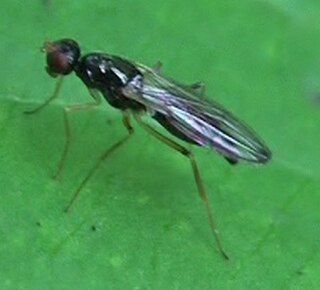
The Lauxanioidea are a superfamily of flies that includes the two large families, the Lauxaniidae and Chamaemyiidae, and the small family Celyphidae. Generally, they are small to medium, densely populated, coloured flies. The Chamaemyiidae and Cremifaniidae live as parasites on insects. The family Celyphidae look like beetles.

The Micropezidae are a moderate-sized family of acalyptrate muscoid flies in the insect order Diptera, comprising about 500 species in about 50 genera and five subfamilies worldwide,. They are most diverse in tropical and subtropical habitats, especially in the Neotropical Region.

The Lauxaniidae are a family of acalyptrate flies. They generally are small flies with large compound eyes that often are brightly coloured in life, sometimes with characteristic horizontal stripes, such as in Cestrotus species. Many species have variegated patterns on their wings, but in contrast they generally do not have variegated bodies, except for genera such as Cestrotus, whose camouflage mimics lichens or the texture of granitic rocks.

The Chamaemyiidae are a small family of acalyptrate flies with less than 200 species described worldwide. The larvae of these small flies are active and predatory and are often used for biological control of aphids, scale insects, and similar pests. Chamaemyiid fossils are poorly represented in amber deposits, but a few examples are known from the Eocene epoch onwards.

The Coelopidae or kelp flies are a family of Acalyptratae flies, they are sometimes also called seaweed flies, though both terms are used for a number of seashore Diptera. Fewer than 40 species occur worldwide. The family is found in temperate areas, with species occurring in the southern Afrotropical, Holarctic, and Australasian regions.

The Pyrgotidae are an unusual family of flies (Diptera), one of only two families of Cyclorrhapha that lack ocelli. Most species are "picture-winged", as is typical among the Tephritoidea, but unlike other tephritoids, they are endoparasitoids; the females pursue scarab beetles in flight, laying an egg on the beetle's back under the elytra where the beetle cannot reach it. The egg hatches and the fly larva enters the body cavity of the beetle, feeding and eventually killing the host before pupating. In the United States, some species of Pyrgota and Sphecomyiella can be quite common in areas where their host beetles are abundant. Like their host beetles, these flies are primarily nocturnal, and are often attracted to artificial lights.

The Strongylophthalmyiidae are a small family of about 80 species of slender, long-legged flies, the majority of which occur in the Oriental and Australasian regions. They are divided into two genera, the monotypic Southeast Asian genus Nartshukia Shatalkin, 1993 and Strongylophthalmyia Heller, 1902. The relationships of the group are obscure; formerly the genus Strongylophthalmyia was classified with the Psilidae, and some recent classifications place it within the Tanypezidae. Little is known of their biology, but many species seem to be associated with rotting bark.

Terellia is a genus of tephritid or fruit flies in the family Tephritidae.

Platystomatinae is a subfamily of flies (Diptera) in the family Platystomatidae that includes 80 genera, the largest subfamily with at last estimate, c. 900 species globally.
The broad-headed flies is a subfamily of flies. Until 2010, they were known from only one species based on four specimens and placed in the family Eurychoromyiidae.
Acelyphus is a genus of beetle flies. It is known from the Indomalayan realm.
Celyphus is a genus of beetle flies. It is known from the Oriental and Afrotropical realms. Up to 1859, all species of beetle flies were placed in this genus.

Spaniocelyphus is a genus of beetle flies known from the Indomalayan realm.
Idiocelyphus is a genus of beetle flies. It is known from the Indomalayan realm. Most are from the Philippines.

Cestrotus is a genus of brachyceran flies in the family Lauxaniidae.
Pterogramma is a genus of flies belonging to the family of the Lesser Dung flies.

Tephritini is a tribe of fruit flies in the family Tephritidae. There are about 12 genera and at least 40 described species in Tephritini.

Xenochaetina is a genus of flies in the family Lauxaniidae. There are about 11 described species in Xenochaetina.

Neogriphoneura is a genus of flies in the family Lauxaniidae. There are about 11 described species in Neogriphoneura.
JoAnn Marie Tenorio was an American entomologist who also worked in publishing in Hawaii. She was co-author of two popular manuals, What Bit Me? (1993) and What's Bugging Me? (1995).















